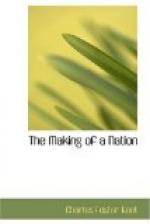The most primitive races believed that some great animal created the earth and man. In the Alaskan collection in the museum of the University of Pennsylvania there is a huge crow, sitting upon the mask of a man’s face. This symbolizes the crude belief of the Alaskan Indians regarding the way man was created. The early Egyptians thought that the earth and man were hatched out of an egg. In one part of Egypt it was held that the artisan god Ptah broke the egg with his hammer. In another part of the land and probably at a later date the tradition was current that Thoth the moon god spoke the world into existence. The earliest Babylonian record states that:
The god Marduk laid a reed on the face
of the waters,
He formed dust and poured it out beside
the reed;
That he might cause the gods to dwell
in the dwellings
of their heart’s desire,
He formed mankind.
Later he formed the grass and the rush of the marsh and the forest. Then he created the animals and their young.
The Parsee teachers held that the rival gods, Ahriman and Ormuzd, evolved themselves out of primordial matter and then through the long ages created their attendant hierarchies of angels. The philosophers of India anticipated in some respects our modern evolutionary theory. Brahma is thought of as self-existent and eternal. He gradually condenses himself into material objects, such as ether, fire, water, earth and the elements. Last of all he manifests himself in man. The Greek philosophers were the first to attempt to describe creation as a purely physical, generative process. They taught the evolution of the more complex from the simpler forms. Plato and Aristotle believed in a transcendental deity and found in the world indications of a vital impulse toward a higher manifestation of life—man.
Michael Angelo, with wonderful dramatic power, in his painting in the Sistine Chapel at Rome has portrayed how lifeless clay in form of man, when touched by the finger of God, by sheer vitalizing power is transformed into a living soul.
Very different yet equally impressive is the modern scientific view. The origin of matter and of life is so absolutely unknown that scientists have not as yet formulated definite theories concerning it. Even the theories regarding the origin of the solar system are still conflicting and none is generally accepted. The old nebular hypothesis is discredited and the theory of the spiral movement of the solar matter seems to be confirmed by phenomena observable in the heavens. The one principle generally held by scientists is that, given matter and life and some creating force, our present marvelous complex universe has come into being according to laws usually called natural. These laws are so invariable that they may be considered unchanging.




